#Leading Blockchain Developers
Explore tagged Tumblr posts
Text
Navigating the Blockchain Horizon - Nadcab Labs Expertise in Exchange Listings

Introduction to Nadcab Labs:
Nadcab Labs is recognized as a leading developer in the blockchain industry. This prominence stems from their deep expertise and innovative contributions in blockchain technology. They have carved a niche in the market by offering specialized services that cater to various aspects of blockchain development and deployment, particularly in the realm of cryptocurrency exchanges.
Services Offered by Nadcab Labs
Exchange Listing:
Definition and Importance: Explain what exchange listing means in the context of blockchain and cryptocurrency.
Nadcab Labs Approach: Describe how Nadcab Labs assists clients in getting their digital assets listed on cryptocurrency exchanges.
2. Tier 1 Exchange Listing:
Significance of Tier 1 Exchanges: Discuss the benefits and prestige associated with listing on Tier 1 exchanges, which are known for their high liquidity and large user base.
Nadcab Labs Strategy: Outline the strategies and support Nadcab provides to achieve listings on these prominent exchanges.
3. Exchange Market Making Listing:
Market Making Explained: Clarify the concept of market making in crypto exchanges and its importance for liquidity.
Nadcab Labs Role: Detail how Nadcab aids in establishing effective market making strategies for their clients' listings.
4. Exchange Launchpad Program Listing:
Launchpad Programs: Explain what launchpad programs are and their role in supporting new cryptocurrencies or projects.
Nadcab Labs Involvement: Describe how Nadcab Labs assists in getting projects listed on these launchpad programs, which can be crucial for initial exposure and funding.
Importance of Exchange Listings in Blockchain:
Impact on Projects: Discuss how being listed on exchanges can significantly impact the visibility and success of blockchain projects.
Nadcab Labs Unique Advantage: Emphasize the unique benefits and expertise Nadcab offers in this area, setting them apart from competitors.
Conclusion:
Summarize the key points about Nadcab Labs services.
Highlight the future potential for companies collaborating with Nadcab in the ever-evolving blockchain market.
0 notes
Text
Developer Advocate - AI & Blockchain Lead
Job title: Developer Advocate – AI & Blockchain Lead Company: Career Renew Job description: Career Renew is recruiting for one of its clients a Developer Advocate – AI & Blockchain Lead – this is a fully remote… US-based role. About the role: As the AI & Blockchain Lead – Developer Advocate at Hashgraph, you’ll have a unique… Expected salary: Location: USA Job date: Wed, 09 Apr 2025 22:28:15…
0 notes
Text
0 notes
Text
Cybercriminals are abusing Google’s infrastructure, creating emails that appear to come from Google in order to persuade people into handing over their Google account credentials. This attack, first flagged by Nick Johnson, the lead developer of the Ethereum Name Service (ENS), a blockchain equivalent of the popular internet naming convention known as the Domain Name System (DNS). Nick received a very official looking security alert about a subpoena allegedly issued to Google by law enforcement to information contained in Nick’s Google account. A URL in the email pointed Nick to a sites.google.com page that looked like an exact copy of the official Google support portal.
As a computer savvy person, Nick spotted that the official site should have been hosted on accounts.google.com and not sites.google.com. The difference is that anyone with a Google account can create a website on sites.google.com. And that is exactly what the cybercriminals did. Attackers increasingly use Google Sites to host phishing pages because the domain appears trustworthy to most users and can bypass many security filters. One of those filters is DKIM (DomainKeys Identified Mail), an email authentication protocol that allows the sending server to attach a digital signature to an email. If the target clicked either “Upload additional documents” or “View case”, they were redirected to an exact copy of the Google sign-in page designed to steal their login credentials. Your Google credentials are coveted prey, because they give access to core Google services like Gmail, Google Drive, Google Photos, Google Calendar, Google Contacts, Google Maps, Google Play, and YouTube, but also any third-party apps and services you have chosen to log in with your Google account. The signs to recognize this scam are the pages hosted at sites.google.com which should have been support.google.com and accounts.google.com and the sender address in the email header. Although it was signed by accounts.google.com, it was emailed by another address. If a person had all these accounts compromised in one go, this could easily lead to identity theft.
How to avoid scams like this
Don’t follow links in unsolicited emails or on unexpected websites.
Carefully look at the email headers when you receive an unexpected mail.
Verify the legitimacy of such emails through another, independent method.
Don’t use your Google account (or Facebook for that matter) to log in at other sites and services. Instead create an account on the service itself.
Technical details Analyzing the URL used in the attack on Nick, (https://sites.google.com[/]u/17918456/d/1W4M_jFajsC8YKeRJn6tt_b1Ja9Puh6_v/edit) where /u/17918456/ is a user or account identifier and /d/1W4M_jFajsC8YKeRJn6tt_b1Ja9Puh6_v/ identifies the exact page, the /edit part stands out like a sore thumb. DKIM-signed messages keep the signature during replays as long as the body remains unchanged. So if a malicious actor gets access to a previously legitimate DKIM-signed email, they can resend that exact message at any time, and it will still pass authentication. So, what the cybercriminals did was: Set up a Gmail account starting with me@ so the visible email would look as if it was addressed to “me.” Register an OAuth app and set the app name to match the phishing link Grant the OAuth app access to their Google account which triggers a legitimate security warning from [email protected] This alert has a valid DKIM signature, with the content of the phishing email embedded in the body as the app name. Forward the message untouched which keeps the DKIM signature valid. Creating the application containing the entire text of the phishing message for its name, and preparing the landing page and fake login site may seem a lot of work. But once the criminals have completed the initial work, the procedure is easy enough to repeat once a page gets reported, which is not easy on sites.google.com. Nick submitted a bug report to Google about this. Google originally closed the report as ‘Working as Intended,’ but later Google got back to him and said it had reconsidered the matter and it will fix the OAuth bug.
11K notes
·
View notes
Text
https://innosoft.ae/top-blockchain-software-development-companies-in-india/
India has become a center for blockchain innovation, with many development companies providing advanced solutions across various sectors. As more businesses embrace decentralized technologies, selecting the right blockchain software development company is essential. This list of the top 10 blockchain development companies in India for 2025 showcases industry leaders recognized for their skills in smart contracts, DeFi, NFTs, and enterprise blockchain applications. These companies offer secure, scalable, and innovative solutions designed to meet a wide range of business requirements. Whether for startups or large enterprises, businesses can count on these blockchain development firms in India for innovative, future-ready blockchain applications.
#blockchain development companies India#top blockchain development companies 2025#blockchain technology services#best blockchain software development companies India#top blockchain software developers India#leading blockchain technology companies#best blockchain solution providers India#enterprise blockchain development India#custom blockchain software developers India#top blockchain startups in India#blockchain consulting companies India#enterprise blockchain solutions#blockchain software solution provider#blockchain startups India#blockchain consulting firms
0 notes
Text
2024 Tokenization Boom: A New Era for Real-World Assets

In 2024, the landscape of real-world asset (RWA) tokenization is experiencing a transformative shift, marking a significant milestone in the financial industry. Tokenization converts physical assets like real estate, commodities, and art into digital tokens on a blockchain, enhancing liquidity, accessibility, transparency, and security. This revolutionary technology makes high-value assets more accessible to a broader range of investors. As we explore the current state and future prospects of tokenization, it is clear that this technology is set to reshape the global financial ecosystem significantly.
Tokenization is predicted to be a multi-trillion-dollar opportunity by 2030, with market estimates suggesting it could reach up to $16 trillion. The United States is leading this revolution, followed by countries like Singapore, the United Kingdom, Switzerland, India, and Luxembourg.
The total value locked in tokenized assets has surged to $10.53 billion, with major financial institutions launching tokenized investment products. This signals a major inflection point for the industry, underscoring the significant role tokenization will play in the future of finance.
The benefits of tokenization are extensive. It allows for fractional ownership, increasing liquidity and enabling investors to buy and sell portions of an asset. This democratizes investment opportunities and bridges the gap between traditional and digital financial markets. Tokenization also reduces transaction costs by eliminating intermediaries and automating processes through smart contracts.
As regulatory frameworks evolve and technology advances, tokenization is set to revolutionize the financial industry. Intelisync provides cutting-edge RWA tokenization services to help you navigate and capitalize on this financial Learn more....
#metaverse development company#blockchain development companies#web3 development#blockchain development services#metaverse game development#24/7 Market Access#Access to Real-World Yields#Asset Classes in Tokenization#Benefiting Blockchains#CeFi and DeFi tokenization#CeFi-Based Tokenization Protocols#Commodities#Common Combinations#Credit & Loans#Current Trajectory#DeFi protocols#DeFi-Based Tokenization Protocols#Diverse Asset Classes#Dominance of the U.S.#Emerging Trends#Enhanced Liquidity#Ethereum’s Prominence#Fractional Ownership#Leading Geographies#Leading Geographies in Tokenization#Less Popular Asset Classes#Performance of DeFi Protocols#Popular Asset Classes#Private Credit#Real Estate
1 note
·
View note
Text
During the 2008 recession, my aunt lost her job. Her, her partner, and my three cousins moved across the country to stay with us while they got back on their feet. My house turned from a family of four to a family of nine overnight, complete with three dogs and five cats between us.
It took a few years for them to get a place of their own, but after a few rentals and apartments, they now own a split level ranch in a town nearby. I’ve lost track of how many coworkers and friends have stayed with them when they were in a tight spot. A mother and son getting out of an abusive relationship, a divorcee trying to stay local for his kids while they work out a custody agreement, you name it. My aunt and uncle knew first hand what that kindness meant, and always find space for someone who needed it, the way my parents had for them.
That same aunt and uncle visited me in [redacted] city last year. They are prolific drinkers, so we spent most of the day bar hopping. As we wandered the city, any time we passed a homeless person, my uncle would pull out a fresh cigarette and ask them if they had a light. Regardless of if they had a lighter on hand or not, he offered them a few bucks in exchange, which he explained to me after was because he felt it would be easier for them to accept in exchange for a service, no matter how small.
I work for a company that produces a lot of fabric waste. Every few weeks, I bring two big black trash bags full of discarded material over to a woman who works down the hall. She distributes them to local churches, quilting clubs, and teachers who can use them for crafts. She’s currently in the process of working with our building to set up a recycling program for the smaller pieces of fabric that are harder to find use for.
One of my best friends gives monthly donations to four or five local organizations. She’s fortunate enough to have a tech job that gives her a good salary, and she knows that a recurring donation is more valuable to a non-profit because they can rely on that money month after month, and can plan ways to stretch that dollar for maximum impact. One of those organizations is a native plant trust, and once she’s out of her apartment complex and in a home with a yard, she has plans to convert it into a haven of local flora.
My partner works for a company that is working to help regulate crypto and hold the current bad actors in the space accountable for their actions. We unfortunately live in a time where technology develops far too fast for bureaucracy to keep up with, but just because people use a technology for ill gain doesn’t mean the technology itself is bad. The blockchain is something that she finds fascinating and powerful, and she is using her degree and her expertise to turn it into a tool for good.
I knew someone who always had a bag of treats in their purse, on the odd chance they came across a stray cat or dog, they had something to offer them.
I follow artists who post about every local election they know of, because they know their platform gives them more reach than the average person, and that they can leverage that platform to encourage people to vote in elections that get less attention, but in many ways have more impact on the direction our country is going to go.
All of this to say, there’s more than one way to do good in the world. Social media leads us to believe that the loudest, the most vocal, the most prolific poster is the most virtuous, but they are only a piece of the puzzle. (And if virtue for virtues sake is your end goal, you’ve already lost, but that’s a different post). Community is built of people leveraging their privileges to help those without them. We need people doing all of those things and more, because no individual can or should do all of it. You would be stretched too thin, your efforts valiant, but less effective in your ambition.
None of this is to encourage inaction. Identify your unique strengths, skills, and privileges, and put them to use. Determine what causes are important to you, and commit to doing what you can to help them. Collective action is how change is made, but don’t forget that we need diversity in actions taken.
23K notes
·
View notes
Text
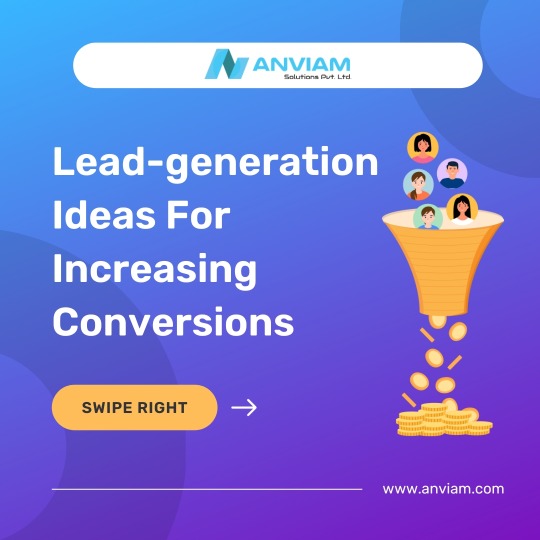

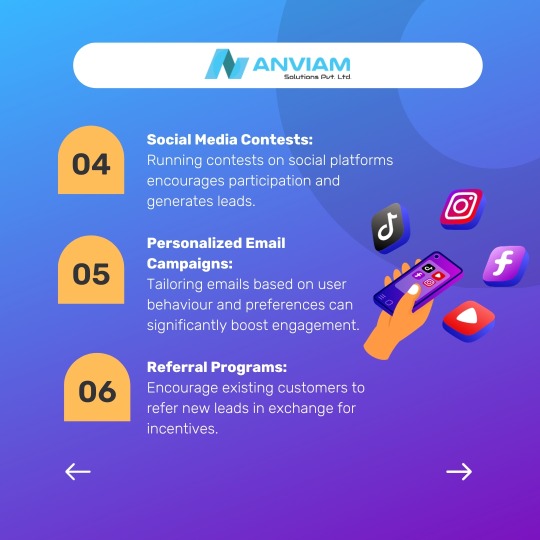
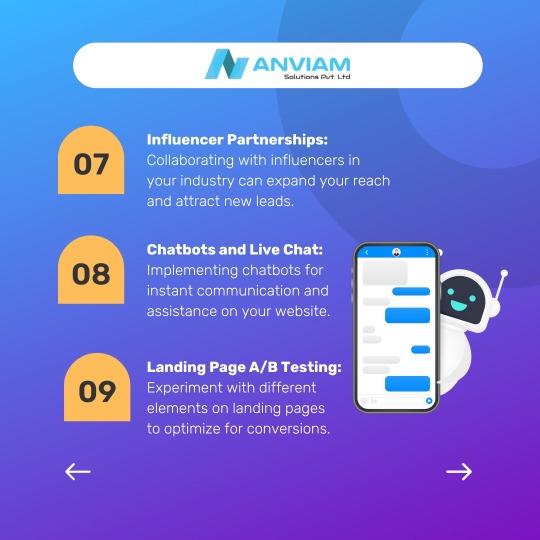
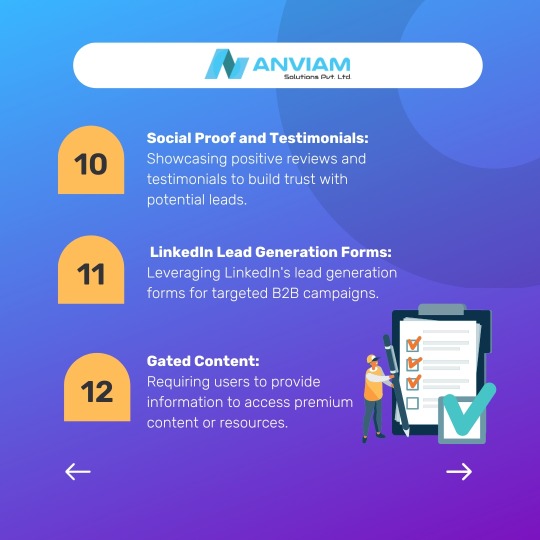
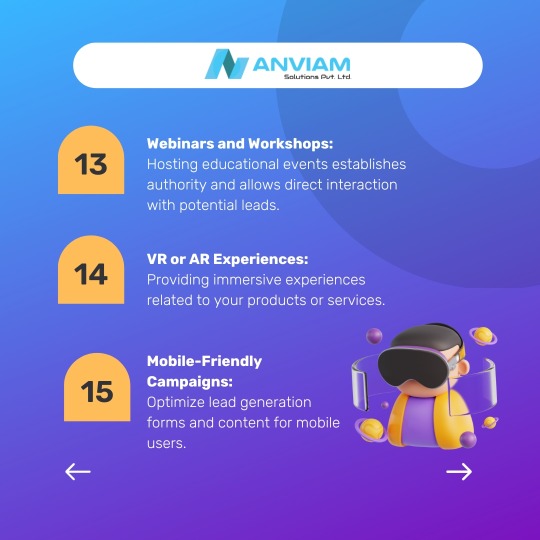
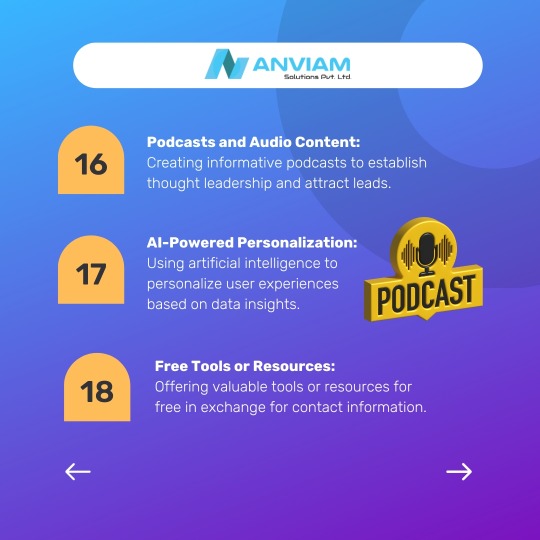
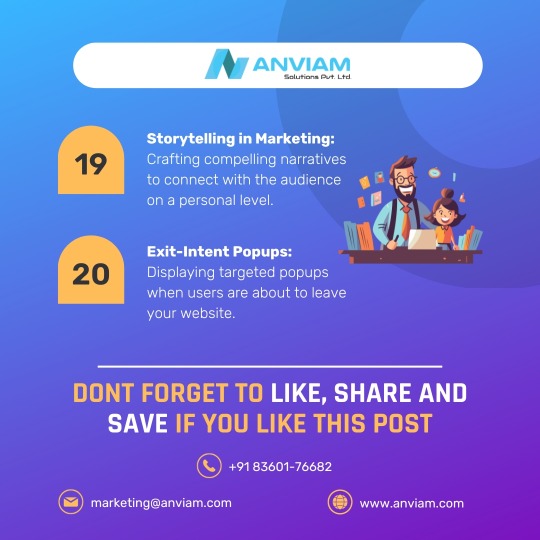
Looking to Lead-Generation Ideas for Increasing Conversions? Look no further! 🎯 At Anviam Solutions, we provide complete info about Lead Generation Ideas for Increasing Conversions Rate.
➢ Customer Surveys ➢ Interactive Content ➢ SEO Optimization ➢ Social Media Contests ➢ Personalized Email Campaigns ➢ Referral Programs ➢ Influencer Partnerships ➢ Chatbots and Live Chat ➢ Landing Page A/B Testing ➢ Social Proof and Testimonials ➢ LinkedIn Lead Generation Forms ➢ Gated Content ➢ Webinars and Workshops ➢ VR or AR Experiences ➢ Mobile-Friendly Campaigns ➢ Podcasts and Audio Content ➢ AI-Powered Personalization ➢ Free Tools or Resources ➢ Storytelling in Marketing ➢ Exit-Intent Popups
Contact us : 📞 +91-8360176682, +91-8054217664 🌐 www.anviam.com 📩 [email protected]
#customer#social media#quality content#seotips#influencers#trends#anviamsolutions#techupgrade#software development#digitalmarketing#blockchain#trending2023#anviam#ideas#lead generation#instadaily
0 notes
Text
Nadcab Labs - Pioneering Blockchain Innovation Across Industries

In the last decade, the blockchain landscape has evolved dramatically, transcending its initial roots in cryptocurrency to become a cornerstone of digital innovation. At the forefront of this revolution is Nadcab Labs, a beacon of progress in blockchain technology.
Nadcab Labs has distinguished itself as a leader in blockchain development. Their work is not confined to the financial sector; it permeates various industries, demonstrating the versatile applications of blockchain technology. Through their cutting-edge research and development.
Finance: A New Era of Trust and Transparency
In finance, Nadcab Labs solutions have introduced a new level of trust and transparency. They are pioneering systems that enhance security and streamline transactions, thereby reducing fraud and inefficiency in financial operations. Nadcab Labs is reshaping the way we think about data security, transparency, and efficiency.
Revolutionizing Supply Chain Management
The impact of Nadcab Labs blockchain technology in supply chain management has been profound. By introducing immutable record-keeping and real-time tracking capabilities, they are addressing longstanding challenges such as counterfeiting, loss, and inefficiency in supply chains.
Healthcare: Securing Patient Data
In healthcare, Nadcab Labs is making strides by implementing blockchain to secure patient data. Their systems ensure that sensitive health information is stored securely and shared with utmost confidentiality, revolutionizing patient care and data management.
Cybersecurity: Fortifying Digital Defences
Nadcab Labs contribution to cybersecurity is particularly noteworthy. They are developing blockchain-based solutions to fortify digital defences against rising cyber threats, ensuring data integrity and security for businesses and individuals alike.
Conclusion
Nadcab Labs relentless pursuit of blockchain excellence is paving the way for a more secure, transparent, and efficient future across various sectors. Their innovative approach and dedication to exploring the full potential of blockchain technology position them as a pivotal player in the digital transformation era.
#blockchain#Leading Blockchain Developers#Best Web3 Developers#Blockchain Application Developers#nadcablabs
1 note
·
View note
Text
The Metaverse: A New Frontier in Digital Interaction

The concept of the metaverse has captivated the imagination of technologists, futurists, and businesses alike. Envisioned as a collective virtual shared space, the metaverse merges physical and digital realities, offering immersive experiences and unprecedented opportunities for interaction, commerce, and creativity. This article delves into the metaverse, its potential impact on various sectors, the technologies driving its development, and notable projects shaping this emerging landscape.
What is the Metaverse?
The metaverse is a digital universe that encompasses virtual and augmented reality, providing a persistent, shared, and interactive online environment. In the metaverse, users can create avatars, interact with others, attend virtual events, own virtual property, and engage in economic activities. Unlike traditional online experiences, the metaverse aims to replicate and enhance the real world, offering seamless integration of the physical and digital realms.
Key Components of the Metaverse
Virtual Worlds: Virtual worlds are digital environments where users can explore, interact, and create. Platforms like Decentraland, Sandbox, and VRChat offer expansive virtual spaces where users can build, socialize, and participate in various activities.
Augmented Reality (AR): AR overlays digital information onto the real world, enhancing user experiences through devices like smartphones and AR glasses. Examples include Pokémon GO and AR navigation apps that blend digital content with physical surroundings.
Virtual Reality (VR): VR provides immersive experiences through headsets that transport users to fully digital environments. Companies like Oculus, HTC Vive, and Sony PlayStation VR are leading the way in developing advanced VR hardware and software.
Blockchain Technology: Blockchain plays a crucial role in the metaverse by enabling decentralized ownership, digital scarcity, and secure transactions. NFTs (Non-Fungible Tokens) and cryptocurrencies are integral to the metaverse economy, allowing users to buy, sell, and trade virtual assets.
Digital Economy: The metaverse features a robust digital economy where users can earn, spend, and invest in virtual goods and services. Virtual real estate, digital art, and in-game items are examples of assets that hold real-world value within the metaverse.
Potential Impact of the Metaverse
Social Interaction: The metaverse offers new ways for people to connect and interact, transcending geographical boundaries. Virtual events, social spaces, and collaborative environments provide opportunities for meaningful engagement and community building.
Entertainment and Gaming: The entertainment and gaming industries are poised to benefit significantly from the metaverse. Immersive games, virtual concerts, and interactive storytelling experiences offer new dimensions of engagement and creativity.
Education and Training: The metaverse has the potential to revolutionize education and training by providing immersive, interactive learning environments. Virtual classrooms, simulations, and collaborative projects can enhance educational outcomes and accessibility.
Commerce and Retail: Virtual shopping experiences and digital marketplaces enable businesses to reach global audiences in innovative ways. Brands can create virtual storefronts, offer unique digital products, and engage customers through immersive experiences.
Work and Collaboration: The metaverse can transform the future of work by providing virtual offices, meeting spaces, and collaborative tools. Remote work and global collaboration become more seamless and engaging in a fully digital environment.
Technologies Driving the Metaverse
5G Connectivity: High-speed, low-latency 5G networks are essential for delivering seamless and responsive metaverse experiences. Enhanced connectivity enables real-time interactions and high-quality streaming of immersive content.
Advanced Graphics and Computing: Powerful graphics processing units (GPUs) and cloud computing resources are crucial for rendering detailed virtual environments and supporting large-scale metaverse platforms.
Artificial Intelligence (AI): AI enhances the metaverse by enabling realistic avatars, intelligent virtual assistants, and dynamic content generation. AI-driven algorithms can personalize experiences and optimize virtual interactions.
Wearable Technology: Wearable devices, such as VR headsets, AR glasses, and haptic feedback suits, provide users with immersive and interactive experiences. Advancements in wearable technology are critical for enhancing the metaverse experience.
Notable Metaverse Projects
Decentraland: Decentraland is a decentralized virtual world where users can buy, sell, and develop virtual real estate as NFTs. The platform offers a wide range of experiences, from gaming and socializing to virtual commerce and education.
Sandbox: Sandbox is a virtual world that allows users to create, own, and monetize their gaming experiences using blockchain technology. The platform's user-generated content and virtual real estate model have attracted a vibrant community of creators and players.
Facebook's Meta: Facebook's rebranding to Meta underscores its commitment to building the metaverse. Meta aims to create interconnected virtual spaces for social interaction, work, and entertainment, leveraging its existing social media infrastructure.
Roblox: Roblox is an online platform that enables users to create and play games developed by other users. With its extensive user-generated content and virtual economy, Roblox exemplifies the potential of the metaverse in gaming and social interaction.
Sexy Meme Coin (SEXXXY): Sexy Meme Coin integrates metaverse elements by offering a decentralized marketplace for buying, selling, and trading memes as NFTs. This unique approach combines humor, creativity, and digital ownership, adding a distinct flavor to the metaverse landscape. Learn more about Sexy Meme Coin at Sexy Meme Coin.
The Future of the Metaverse
The metaverse is still in its early stages, but its potential to reshape digital interaction is immense. As technology advances and more industries explore its possibilities, the metaverse is likely to become an integral part of our daily lives. Collaboration between technology providers, content creators, and businesses will drive the development of the metaverse, creating new opportunities for innovation and growth.
Conclusion
The metaverse represents a new frontier in digital interaction, offering immersive and interconnected experiences that bridge the physical and digital worlds. With its potential to transform social interaction, entertainment, education, commerce, and work, the metaverse is poised to revolutionize various aspects of our lives. Notable projects like Decentraland, Sandbox, Meta, Roblox, and Sexy Meme Coin are at the forefront of this transformation, showcasing the diverse possibilities within this emerging digital universe.
For those interested in the playful and innovative side of the metaverse, Sexy Meme Coin offers a unique and entertaining platform. Visit Sexy Meme Coin to explore this exciting project and join the community.
276 notes
·
View notes
Text
This post is a very long rant about Generative AI. If you are not in the headspace to read such content right now, please continue scrolling.
....
....
It has come to my attention that a person who I deeply admire is Pro-AI. Not just Pro-AI, but has become a shill for a multi-billion dollar corporation to promote their destructive generative AI tools, and is doing it voluntarily and willingly. This person is a creative professional and should know better, and this decision by them shows a lack of integrity and empathy for their fellow creatives. They have sold out to not just their own destruction, but to everyone around them, without any concern. It thoroughly disgusts and disappoints me.
Listen, I am not against technological advancements. While I am never the first to adopt a new technology, I have marveled at the leaps and bounds that have been made within my own lifetime, and welcome progress. Artificial Intelligence and Machine Learning models certainly have their place in this world. Right now, scientific researchers are using advanced AI modeling to discover new protein configurations using a program called Alpha-Fold, and the millions of new proteins that were discovered have gone on to the development of life saving cancer treatments, vaccine development, and looking for new ways to battle drug-resistant bacterial infections. Machine learning models are being developed to track and predict climate change with terrifying accuracy, discover new species, researching new ways of dealing with plastic waste and CO2/methane, and developing highly accurate tools for early detection of cancers. These are all amazing advancements that have only been made possible by AI and will save countless millions of lives. THIS is what AI should be used for.
Generative AI, however, is a different beast entirely. It is problematic in many ways, and is destructive by its very nature. All the current models were trained on BILLIONS of copyrighted materials (images, music, text), without the creator's consent or knowledge. That in and of itself is highly unethical. In addition, these computers that run these GenAI programs use an insane amount of resources to run, and are a major contributor to climate change right now, even worse than the NFT and blockchain stuff a few years ago.
GenAI literally takes someone's hard work, puts it into an algorithm that chews it up and spits out some kind of abomination, all with no effort on the part of the user. And then these "creations" are being sold by the boatload, crowding out legitimate artists and professional creatives. Artists like myself and thousands of others who rely on income from art. Musicians, film makers, novelists, and writers are losing as well. It is an uphill battle. The market is flooded right now with so many AI generated art and books that actual artists and writers are being buried. To make matters worse, these generated works often have inaccuracies and spread misinformation and and lead to injury or even death. There are so many AI generated books, for example, about pet care and foraging for plants that are littered with inaccurate and downright dangerous information. Telling people that certain toxic plants are safe to eat, or giving information on pet care that will lead to the animal suffering and dying. People are already being affected by this. It is bad enough when actual authors spread misinformation, but when someone can generate an entire book in a few seconds, this gets multiplied by several orders of magnitude. It makes finding legitimate information difficult or even downright impossible.
GenAI seeks to turn the arts into a commodity, a get-rich-quick money making scheme, which is not the point of art. Automating art should never be the goal of humanity. Automating dangerous and tedious tasks is important for progress, but automating art is taking away our humanity. Art is all about the human experience and human expression, something a machine cannot ever replicate and it SHOULDN'T. Art should come from the heart and soul, not some crap that is mass produced to make a quick buck. Also developing your skills as an artist, whether that is through drawing, painting, sculpture, composing music, songwriting, poetry, creative writing, animation, photography, or making films, are not just about human expression but develop your brain and make you a more well rounded person, with a rich and deep experience and emotional connection to others. Shitting out crappy art and writing just to make a quick dollar defeats the entire purpose of all of that.
In addition, over-reliance on automated and AI tools is already leading to cognitive decline and the deterioration of critical thinking skills. When it is so easy to click a button and generate a research paper why bother putting the work in? Students are already doing this. Taking the easy way out to get a grade, but they are only hurting themselves. When machines do your thinking for you, what is there left to do? People will lose the ability to develop even basic skills.
/rant
By the way if any tech bros come at me you will be blocked without warning. This is not up for debate or discussion.
#ladyaldhelm ramblings#fuck ai#no ai#fuck generative ai#rant#support human artists#no ai art#no ai writing#anti ai#anti generative ai#ai fuckery#ai bullshit#anti ai art#down with ai#ai art is not art
110 notes
·
View notes
Text

Elon Musk’s Five-Pronged Approach to Reducing Government
Elon Musk, the billionaire entrepreneur behind Tesla, SpaceX, and X (formerly Twitter), has long been vocal about his concerns regarding excessive government intervention. Whether it’s through regulatory pushback, decentralization efforts, or technological disruption, Musk is actively working to reduce government influence in five key ways.
1. Challenging Regulatory Overreach
Musk has repeatedly criticized government regulations that he believes stifle innovation. From Tesla’s battles with dealership laws to SpaceX’s friction with the Federal Aviation Administration (FAA), he has frequently clashed with authorities over what he sees as unnecessary red tape. By publicly pushing back against these restrictions, he aims to set precedents that could lead to reduced regulatory burdens across industries.
2. Privatizing Space Exploration
NASA was once the sole player in space exploration, but SpaceX has shifted the industry toward privatization. By reducing dependence on government-funded programs and proving that private companies can outperform traditional bureaucratic models, Musk is driving a shift away from government monopolization of space travel.
3. Advocating for Free Speech and Decentralization
After acquiring Twitter (now X), Musk positioned himself as a champion of free speech, often criticizing government involvement in content moderation. He has also expressed support for decentralized social media and blockchain technologies, which could reduce reliance on centralized, government-regulated platforms.
4. Developing Alternative Energy and Infrastructure
Tesla’s push for electric vehicles and solar power indirectly challenges government-controlled energy industries. By promoting self-sufficient energy solutions, such as home battery storage and off-grid living, Musk is creating alternatives that reduce reliance on state-controlled utilities and fossil fuel subsidies.
5. Advancing AI and Automation to Limit Government’s Role
Musk has a complex stance on artificial intelligence (AI), both warning about its dangers and investing in its development through xAI. By accelerating automation, he envisions a future where technology reduces the need for bureaucratic inefficiencies, potentially shrinking government involvement in areas like labor regulation and public sector jobs.
Conclusion
Musk’s efforts to reduce government influence aren’t just theoretical; they manifest in tangible actions across multiple industries. Whether he succeeds or not remains to be seen, but his impact is already reshaping the relationship between innovation and regulation.
#news update#politics#usa news#us politics#donald trump#news#public news#world news#breaking news#latest updates#opinion#elon musk#protest#nonbinary#transgender#tweets#anti trump#president trump#trump administration#inauguration#trump 2024#fuck trump#maga#jd vance#trump#us news#usa politics#us presidents#us propaganda#us polls
26 notes
·
View notes
Text

ERC20 token generator
Ever wanted to create your own cryptocurrency? Thanks to the ERC20 Token Generator, it’s more accessible than ever. Dive into the world of blockchain and see how simple it can be.
What is an ERC20 Token?
ERC20 tokens are digital assets built on the Ethereum blockchain. They follow a specific standard, allowing them to interact seamlessly with platforms and other tokens.
Benefits of ERC20 Tokens:
Interoperability: All ERC20 tokens adhere to the same protocol.
Widespread Acceptance: Many platforms on Ethereum support these tokens.
Developer Support: Extensive documentation and community support.
How Does the ERC20 Token Generator Work?
Creating a token might sound complex, but the ERC20 Token Generator simplifies the process. Here’s a step-by-step guide:
Define Your Token:
Choose a name and symbol.
Set the total supply.
Access the Generator:
Use online tools designed for token creation.
Input your token details.
Deploy to the Blockchain:
Confirm your details.
Launch your token on the Ethereum network.
Key Features of ERC20 Tokens
These tokens offer various features that make them attractive for both developers and investors:
Standardized Functions: Such as balance checking and transfers.
Smart Contract Integration: Seamlessly integrate with smart contracts.
Security: Built on the robust Ethereum blockchain.
Why Create an ERC20 Token?
Creating your own token can offer several advantages:
Fundraising: Launch your own ICO (Initial Coin Offering).
Community Building: Reward loyal customers or followers.
Innovation: Develop new applications and uses for blockchain.
Potential Challenges
Despite the ease of creation, there are challenges:
Technical Knowledge: Basic understanding of blockchain is required.
Security Risks: Vulnerabilities can lead to exploitation.
Regulatory Issues: Compliance with local laws is crucial.
Best Practices for Creating ERC20 Tokens
To ensure success, follow these guidelines:
Audit Your Code: Ensure there are no security loopholes.
Engage with the Community: Gather feedback and make improvements.
Stay Informed: Keep up with blockchain trends and regulations.
Conclusion
The ERC20 Token Generator opens doors to the exciting world of cryptocurrency creation. Whether you're an entrepreneur, developer, or enthusiast, it offers an innovative way to engage with blockchain technology.
Final Thoughts
Creating an ERC20 token can be a game-changer. It empowers you to participate in the digital economy and experiment with new ideas.
FAQs
1. What is an ERC20 Token Generator?
An ERC20 Token Generator is a tool that simplifies the creation of custom tokens on the Ethereum blockchain.
2. Is technical knowledge necessary to create a token?
Basic blockchain understanding is helpful, but many generators offer user-friendly interfaces.
3. Can I sell my ERC20 tokens?
Yes, you can list them on cryptocurrency exchanges or sell directly to users.
4. Are there costs associated with creating a token?
Yes, deploying tokens on Ethereum requires gas fees, paid in Ether.
5. How do I ensure my token is secure?
Regular code audits and following best practices can enhance security.
Source : https://www.altcoinator.com/
#erc20#erc20 token development company#erc#erc20tokengenerator#token#token generator#token creation#ethereum#bitcoin
57 notes
·
View notes
Text
The Future
It's always grating to read or listen to random members of the public talk about AI in the media, and it is much more grating to listen to "futurists" or politicians or so-called experts who have absolutely no domain expertise nor background in machine learning talk about things "AI" will be able to do in the future. A lot of the time, they will predict that AI (which means conversational agents based on large language models trained with transformers and attention) will do things in the future that can already be done by humans, and by computers without any AI, machine learning, or large text corpora, back in the 90s. Politicians on the other hand sometimes use "AI" to deflect criticisms of infeasible ideas. How will this work, exactly? AI!
Sometimes using AI as a buzzword is the point. Nobody wants to hear "we will develop another app".
It usually doesn't take extreme forms like "In the future, AI will allow us to transplant human hearts", but I have seen weaker forms like "In the future, technologies like ChatGPT will make genome-wide association studies and automatic drug discovery possible". You don't need large language models for GWAS or drug discovery. The data sets for this are very different, and I doubt a system like ChatGPT could just absorb a large CSV file of medial data if you pasted it into the conversation.
If you look at claims about "the future" from the recent past, you see the same thing said about blockchain, web 2.0 mash-ups and tagging, the semantic web/ontologies, smart homes, and so on. "In the future, we will all have smart fridges" – "In the future you will begin your day by asking Siri what your appointments are and what you should eat for breakfast" – "In the future your PC will print your newspaper at home." – "In the future you will pay for groceries out of your Bitcoin Wallet."
If you push back, and you point out that a this new claim sounds like a bullshit claim about blockchain, smart fridges, and the semantic web, you usually hear "That's what they said about cars. That's what they said about television." Never mind who "they" are. Never mind that they didn't say that about cars, they said that about Bitcoin. Cars are just a massive outlier. Cars were immensely successful, and they were largely unchanged for 120 years, with for wheels and an internal combustion engine that runs on petrol. Cars are noisy, smelly, and dangerous to pedestrians and occupants. For decades, leaded petrol used in cars distributed lead into the air and int the food supply. Cars depend on an infrastructure of asphalt roads and petrol stations. This is different from what they said about CDs or monorail or QR codes or pneumatic tubes. As for TV, it is usually invoked to say "People thought TV would rot our brains, yet here we are". There is no denying that TV had profoundly changed how people spend their time, changed politics, changed how fast the news cycle is, and so on, often for the worse.
It's so easy to refute "that's what they said about cars" that I could probably fill 50 A4 pages with the history of technologies that failed in some way, purely from memory, and then find old newspaper quotes from optimists and futurists that compared the naysayers (correct in hindsight) with car skeptics, and I could fill another 50 pages with ways inventions like cars and TV and the Internet profoundly changed society, and then find quotes from futurists that explain that the Internet is really just a better fax machine, and the car is like a faster horse, so we have nothing to worry about.
There's another way to dismiss skeptics of new technology, and it's harder to refute, even though it operates on the same kind of hindsight bias:
Imagine the year is 1995. What couldn't you achieve if only you knew that computers and the Internet would be big? Imagine you can send a letter to yourself in 1995. Wouldn't you want to tell your former self that the Internet will be the Next Big Thing? Wouldn't you want to tell your former self that by 2015, everybody will have an Internet-connected computer in their pockets?
It's easy to refute the hindsight bias of "that's what they said about cars" with example after example of technologies that didn't catch on for 100 years like cars did.
Where's the error here? If you say something like "Language-model AI is the future! Wouldn't you rather get on the bandwagon sooner than later?" you risk investing your money into a scam just to get in on the ground floor.
But really think it through: Imagine the year is 1985. A time traveller tells you that computers are going to be big. Everybody is going to have one. What do you do? Do you quit your job and work in the computer industry? If not, do you buy a computer? Which one? A C64? An IBM PC XT? Atari ST?
I don't know how much you could really do with this information. Should you invest your savings into Atari? Should you learn to program?
Imagine the year is 1985. A timer traveller tells you that the CD is going to replace vinyl and cassette tapes, then there will be mp3 players, but nothing will really replace mp3 players, and then streaming music from centralised servers will replace mp3 players. Nothing will really replace the CD, but the music industry will be completely different. Nobody will sell music on SD cards, mini discs are better than CDs in terms of technology, but they solve the wrong problem. All the cool indie bands that released free promo mp3s in the 2000s will split up or sell out. "What's an mp3?", you ask.
Imagine the year is 2005. Every pseudo-intellectual Internet commenter seems to think VHS won against BetaMax because of pornography. They are going to produce pornography for HD-DVD. You think Blu-Ray is dead in the water. A time traveller appears, and he tells you that actually, VHS won against BetaMax because the tapes are longer, and it allows you to VCR a long television program. Yes, they are going to produce pornography for the HD-DVD first, but it doesn't matter. Ever since Internet pornography, nobody goes to the sex shop anyway, just to risk coming out of the door with a shopping bag full of HD-DVDs, just as his neighbour's wife is coming out of the liquor store across the street. Still the Blu-ray won't replace DVDs like DVDs replaced VHS, because you can still play a DVD in a Blu-ray player, and it will all be streaming in a couple of years anyway.
What will you do with this information, other than buy a Blu-ray player?
Imagine the year is 1923. A time traveller tells you that cars are going to be big. Really big. Everybody will own one, and a garage. Petrol stations are everywhere already, but soon there will be traffic jams. Cities will be planned for cars, not people.
Should you buy a car now? Should you wait for the technology to mature?
The year is 2025. Somebody tells you that LLMs are going to be big. Bigger than they are. Bigger than ever. Bigger than Jesus. He tells you you're a sucker if you don't use ChatGPT. You think he's right, but you don't work in a job that can be done by ChatGPT. You work at a bakery. Maybe just not yet?
What should you do?
I think the idea that you should get in now, and you will "miss the boat" if you don't learn to use GenAI and conversational agents, that idea is just stupid. It's half special pleading, half Pascal's Wager, and a lot of hindsight bias. You couldn't really "get into" other technologies before they matured. Futurists confidently predicted in 2022 that "prompt engineer" was going to be a job, when obviously companies like Google, Anthropic, and OpenAI had every reason and every incentive to work on making their systems better understand users, to make prompt engineering obsolete. At some point owning a car meant learning to be a car mechanic or having a chauffeur who was your personal car mechanic, and then the technology matured. Cars are more complex now, and harder to repair when something breaks, but they are also more reliable and have diagnostic lights.
So should you use ChatGPT or Claude now, just to get ready for "The Future"? I don't know. All I know is that AI won't be a faster horse.
13 notes
·
View notes
Text
Why Crypto Payments are the Key to Future-Proofing Your Business.
Introduction
In recent years, cryptocurrencies have really been on the radar big time. Big time in ways they're a digital currency that harnesses blockchain technology, which has the potential to completely shake up a lot of different kinds of businesses and transactions. The emergence of cryptocurrencies, especially Bitcoin, has encouraged businesses to think about embracing crypto payments as a way to remain competitive and future-proof their businesses Crypto as an Investment: Volatility and Opportunities
Cryptocurrencies are now a sought-after investment asset, they are extremely volatile. Big swings in crypto prices like Bitcoin and Ethereum have really given investors a chance to do well big time. But of course, that volatility means investors are also risking very big losses, losses like market crashing and real money going up in smoke at the financial winds. In spite of this, most cryptocurrency proponents consider digital currencies a good avenue for diversifying investment portfolios, cognizant of the fact that cryptocurrencies are not stable, long-term assets but speculative investments. For companies, this is a two-edged sword—accepting cryptocurrencies as payment may unlock new revenue streams but companies have to carefully weigh their risk appetite when considering their participation in the world of cryptocurrencies.
Benefits of Acceptance of Crypto Payments
Beyond the risks, moving to accepting different types of cryptocurrency is a win for companies especially those in financial tech. These benefits include:
Lower Transaction Fees: Conventional payment processors and financial intermediaries usually impose high transaction fees. Cryptocurrencies usually have lower transaction fees.
Speedier Transactions: Transactions involving cryptocurrencies are much quicker than traditional banking systems, particularly cross-border payments, where old financial systems take days to clear transactions.
New Customer Bases Access: By embracing cryptocurrency, companies can access a worldwide market of crypto investors and enthusiasts. This gives companies new access to customers who are perhaps excited about making transactions digitally or through decentralized routes.
Improved Security and Fraud Protection: Cryptocurrencies employ encryption and blockchain technology to protect transactions, making it much less likely for fraud or chargebacks to occur.
Challenges and Considerations
Sure, while there are great benefits to adopting cryptocurrency payments for companies, there are also many things to consider and pay attention to. The biggest concern is the built-in price volatility of digital currency, which may lead to unforeseen profits or losses for companies holding crypto assets. To avoid that risk, companies need contingency plans to handle crypto assets and convert them into stable currencies if need be.
Furthermore, the regulatory environment for cryptocurrencies is also developing. Governments across the planet are trying to devise rules and ways to collect taxes on digital money, but some corporations are unsure of their future, because they see rules as unclear and even unstable. Companies should make sure they adapt to local regulations, such as anti-money laundering (AML) and know-your-customer (KYC) regulations, in order to avoid a potential legal battle.
The Future of Cryptocurrency in Business
The increasing use of cryptocurrencies indicates that companies adopting crypto payments now may have a head start in the future. Companies that jump the gun and start taking cryptocurrency payments have a great chance to stand out and lead in their industries. With the rise of blockchain technology, brand new inventions like tokenization, smart contracts has the potential to really change the way all sorts of companies do business, trade and deal with supply chains.
As companies take bigger and bolder steps towards both digitization and decentralized systems, digital currency really offers a nifty shortcut for making transactions slicker, and snappier and also opens new doors to new markets.
Conclusion
In summary, although cryptocurrency payments come with some risks, the potential advantages make them an attractive choice for companies looking to future-proof their business. By embracing crypto payments, companies can lower transaction costs, enhance transaction speed, gain access to new customer bases, and enhance security. Of course, there are still issues like volatility and uncertainty about the rules that get in the way, but for companies that really get involved in companies that use crypto transactions wisely, there can be long-term huge benefits. As the economy keeps changing, embracing cryptocurrency today could make someone a pioneer in the future generation of financial technology.

7 notes
·
View notes
Text
Shui Long Yin VR Metaverse: Technologies and Digital Assets, and the melon about it being released in Summer 2025

What is the metaverse?
The Shui Long Yin metaverse is a parallel world closely resembling the real world, built through the use of digital modelling and technologies such as VR and AR, and designed to exist permanently.
This virtual realm integrates cutting-edge advancements, including blockchain, augmented reality, 5G, big data, artificial intelligence, and 3D engines.
When you acquire a ticket to this world, you gain a digital asset, allowing you to become an immersive citizen within the Shui Long Yin Metaverse.
Every item within Shui Long Yin can be experienced through Augmented Reality using VR devices, providing a seamless blend of the physical and digital realms. These digital assets are permanent, and in some cases, overseas users may trade or transfer their tickets to enter the Shui Long Yin world.
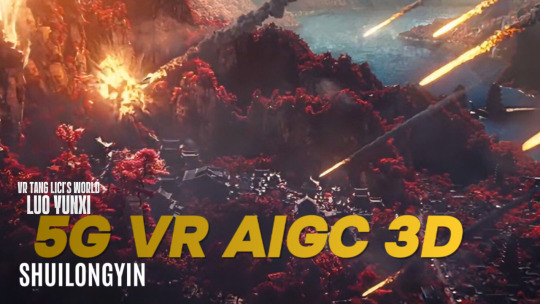
What is VR and AR?
Virtual Reality (VR) is a technology that enables users to interact within a computer-simulated environment.
Augmented Reality (AR), on the other hand, combines elements of VR by merging the real world with computer-generated simulations. A well-known example of AR is the popular game Pokémon Go, where virtual objects are integrated into real-world surroundings.

Tang LiCi's universe
The Shui Long Yin film crew has digitally modeled the core art assets, 50 000 square meters.

What technologies does China Mobile & Migu bring to the table?
China Mobile served as the lead organizer for the 2023 World VR Industry Conference. Its subsidiary, Migu, has also been dedicated to advancing projects in this area.
Shui Long Yin is their first priority this summer 2025.
5G+AI: VR world in Metaverse
AIGC AR 3D: Using AI technology in graphics computer, with the best trained AI system in China.
Video ringtones as a globally pioneering service introduced by China Mobile.
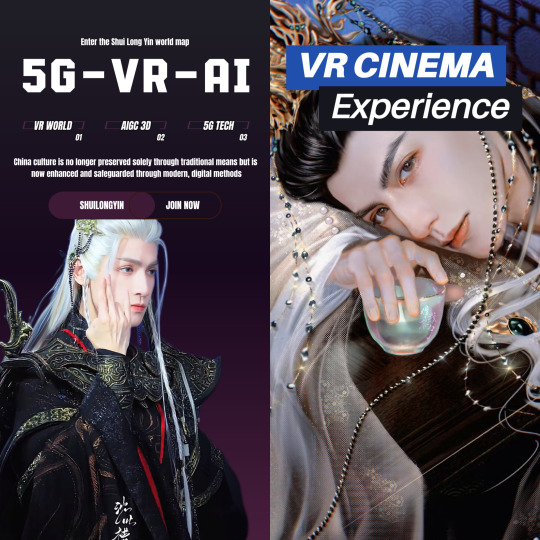
Shui Long Yin from Screen to Metaverse to Real Life: Epic Battles and Intricate Plotlines
The United States and China are world pioneers in the development of TV drama integration VR Metaverse. Notably, Shui Long Yin is the sixth TV drama map worldwide to be merged into the Metaverse.
How can we enjoy these technologies?
-- First we need 5G -- According to a report by the Global Mobile Suppliers Association (GSA), by June 2022:
》There are 70 countries around the world had active 5G networks, you can fully experience all the technology featured in Shui Long Yin.
Example: South Korea, China, and the United States have been at the forefront. Follow after are Japan, United Kingdom, Switzerland, Australia, Taiwan, United Arab Emirates, Saudi Arabia, Viet Nam...
》No worries—even in countries without 5G, you can still watch the drama and enjoy AIGC and 3D technology through the streaming platforms Migu Video and Mango.
•Mango available on IOS and Android, Harmony OS
•Migu (Mobile HD) soon availabe on IOS and Android, Harmony OS
-- Second, we need VR devices --
In country where VR is already commonplace, such as the United States, owning a VR device is considered entirely normal. Users can select devices that best suit their preferred forms of home entertainment.
European countries have also become fairly familiar with VR technology.
However, it is still relatively new to many parts of Asia. When choosing a VR device, it’s important to select one that is most compatible with your intended activities, whether that’s gaming, watching movies, or working.
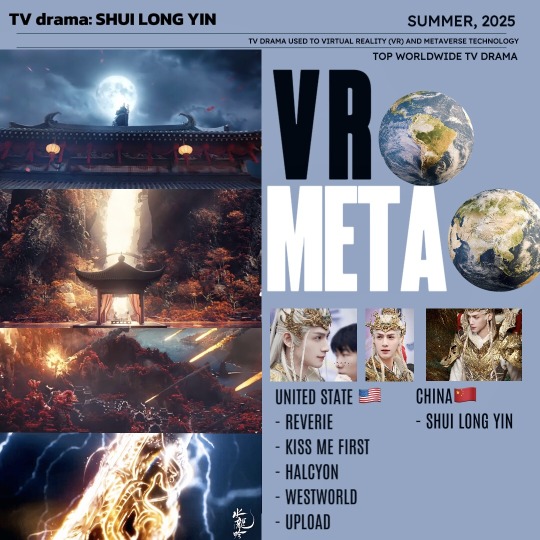
It's no surprise to us that the drama Shui Long Yin will be released in the summer 2025, but it will also be coinciding with offline tourism to Long Yin Town in Chengdu, online VR Metaverse travel, and 3D experiences on the new streaming platforms Migu and Mango. Stay tuned!
Tv drama: SHUI LONG YIN Shui Long Yin & Leo All music and image are copyrighted and belong to the respective owners, included the official film crew SHUILONGYIN.
#shui long yin#tang lici#水龙吟#唐俪辞#luo yunxi#luo yun xi#leo luo#罗云熙#cdrama#chinese drama#long yin town#long yin town vr
5 notes
·
View notes